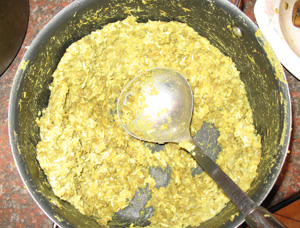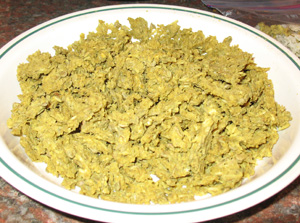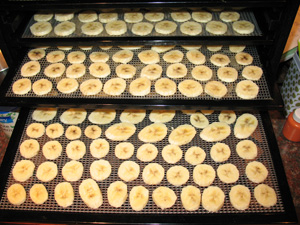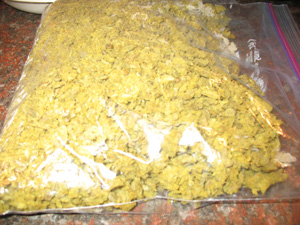For a long time, when it came to multi-day backcountry ski traverses, I thought I have to rely on dried or dry-freeze packaged foods from a store. I won’t mention brands but except one Norwegian and one German brand all the other ones so far tasted the same no matter what kind, and irritated everyone’s throats. Sounds familiar?
 Then while staying at mountain cabins I randomly met people that would pour dried food into boiling water from Ziplocs.
Then while staying at mountain cabins I randomly met people that would pour dried food into boiling water from Ziplocs.
I asked and learnt that they cooked their dinner few days earlier then dehydrated it in a food dryer. “F…ing amazing”, I thought!
Your own food vs. from a store
Everyone likes good food. But most of times by “good food” people are referring only to taste. It is not necessarily healthy, natural and without preservatives or unpronounceable add-ons.
And since today’s food industry has means of making anything taste well or at least descent enough I think it is irrelevant to judge quality of our food only by taste.
On a ski traverse or a long backcountry trip you need quality fuel. You shouldn’t just be trying to get by for a few days. And you don’t need to because:
- If you cook it you know what you put in it.
- It’s cheaper.
- You can have kinds/tastes of dishes you can’t buy in a store.
- Your own tastes way better than artificial flavours can ever create.
- The weight of your own dried dinner portion is the same as a one from the store.
Dehydrated rice dishes for dinners

- They are high in calories.
- They package easily once dried.
- Save gas.
- They absorb water fairly quickly once you want to eat them (about 10min).
- No need to cook them on the trip, just add boiling water (or pour them into boiling water) and let them absorb it with only occasional stirring.
Exact recipe is not important and when it comes to rice Asian cuisine is the king. We usually end up cooking some kind of Indian curry and Tibet/Nepal style dishes – rice with lentils.
Rice is high in carbohydrates (and is even 7% protein) and lentils add protein (30% protein) and other valuable nutrients.
Preparing and drying the rice dishes:
 To prepare these rice dishes you will need only the usual kitchen tools and a food dehydrator.
To prepare these rice dishes you will need only the usual kitchen tools and a food dehydrator.
Suitable temperature and time settings will be in the manual as this depends on type of the dryer.
3 important things to do at this stage:
- Cook the rice and lentils/peas as usual (with all your spices). Once you mix it all up try to get out of it as much water as you can by constantly stirring it while heating the pot on the stove. This way it will take less time to dry the food in a dryer.
- Measure your portions in a bowl before spreading it on the plates that go into the dryer. If you don’t do this then once all is dried you won’t be able to figure out how much of the dried stuff makes up a portion.
- Once dehydrated put it in Ziplocs. We usually put 2-3 portions in one bag since we all eat from the same pot.

On the trip:
I have found out that the food loses a bit of taste during drying but mainly only its saltiness.
Remember to bring some salt and garlic with you and when you add boiling water to your dish add some salt and garlic as well. They will bring all the flavour back.
We usually add some sausage or jerky too which definitely brings up the flavour.
Others like to add butter for taste and fat calories.
Dried bananas and apples

These are great for snacks during long days and if added to morning oatmeal they will absorb water which makes them taste quite fresh.
Preparing and dehydrating:
- Slice bananas into circles and apples into half-circles, about 4mm thick in both cases.
- Dehydrate them separately or check every couple of hours since one fruit might dry faster. Or check the manual for instructions.
Ski traverse foods from John Baldwin
These are not dried food recipes per se but use some dried ingredients. But mainly I wanted to share this page – Expedition food list – with you because John is the guy to ask about winter expedition foods since he completed more than I can imagine anyone do.
Any questions? Or share your recipes and experience

And you guys that already have experience with preparing your own dried food please share it with us.


Stano Faban says
FlandriaRuns, what do you mean by taking long time to boil? That’s when you were hydrating/cooking it once on a trip? If yes, then you don’t need to boil anything. I mean, just boil the water then turn the stove off and put the dehydrated mix in, steer a bit and wait for about 10min. It should be good to go after that. You don’t need to boil/cook the whole dish again. Hope this helps.
FlandriaRuns says
I tried the Indian rice dish and I found that it took a long time to boil. Any tips to help that? Should I dehydrate it in less time? Thanks.
Stano says
Kaj, I used this dehydrator, I usually borrow it from a friend – http://www.excaliburdehydrator.com/dehydrators/non-timer-models/9-tray-large-excalibur-3900b
I was drying the rice dish for about 8-10h I think, with turning it up-side-down halfway through, so it dried evenly.
For temperature, I don’t know because there was a mode on the machine that seemed OK for rice according to the manual.
Kaj says
Nice post- is that a regular oven or a food dehydrator in the photos?
I’ve dehydrated fruit with good results in a normal oven, but haven’t tried rice before. Any tips on times/ temperature for doing rice and lentils in the oven?
frank says
1. There are many long term storable foods out there, but they are not all created equal.
What I don’t like about freeze dried foods is that in the process they often add chemicals to speed up the drying.
That is why I promote dehydrated foods, no added chemicals, dryed at peak nutrition levels and good for 25 years.
Additionally, unlike an MRE the dehydrated foods are high in fiber so they won’t back you up.
Reiner says
Some great ideas, I have dried tomato sauce with great success then all you need is some quick cooking buck wheat noodles and you have a great feast. Just about to head out on a traverse so I will report on some new experiments. Thanks for the post Stano its great to see content like this!
terry says
Stano, yes, just replace the rice. I used to dehydrate brown rice, but switched to quinoa. 1:1, water to quinoa for cooking in a rice cooker.
I use a homemade “Reflectix pot cozy” – do a google search anyone who wants to make one and doesn’t know how – for rehydrating and saving fuel. Boil the dehydrated food a few minutes, then put the pot in the cozy and wait about 10 minutes until done.
Stano says
Terry, thank you for sharing your tip. What kind of a quinoa recipe would you recommend that is “suitable” for drying and as food on a traverse? Just replace the rice?
I know quinoa and do cook it some time but never dehydrated it. But based on its consistency I do believe it can rehydrate faster/easier than rice.
terry says
Thanks for the great post, Stano!
I recommend quinoa for dehydrating. It’s 18% complete protein (9 amino acids) plus carbs and lot of other nutrition. Cook it in a rice cooker. It seems to rehydrate easier than rice as the grains are tiny. Tasty food – give it a try!